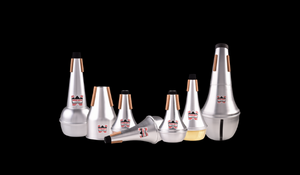How to Prevent Your Mute Change from Becoming a Percussion Solo

.png?width=311&height=181&name=Mutes%20(1).png)
Quick mute changes can very quickly turn a perfectly good brass player into a solo percussionist in the middle of a performance. Has this happened to you? Test-pieces for wind and brass bands often have a situation where whole brass section is muted and indeed many brass players are increasingly called upon to change mutes quickly. Use these tips to prevent your next mute change from becoming a percussion solo!
Quiet in, and Quiet Out
Inserting the mute into the bell can be a little noisy with mute changes. I suggest ease the mute in and out on the corks and to wet the corks with spray as some mutes will squeak against a lacquered bell. Often players are asked to use the pianissimo / practice mutes. These can have severe issues with sound and tuning and so make sure you have a good quality mute (like the Denis Wick Practice mute) to prevent such issues.
As well as making a noise putting the mute in, there is then the issue of getting the mute out of the bell and back on the floor. If the time to do this is limited it can lead to panic and a lot of clunking. I was always recommend having a cloth on the floor to place mutes onto to prevent percussion noises.
Juggling mutes
This tends to be an issue for mainly trumpet cornet and trombone players who need to change the sound of the section through a variety of mutes. Several trumpet and trombone players now use mute stands which can be bought from any good retailer and can fix to a music stand. This is particularly useful as a trumpet player if you must stand and use mutes.
As a trombone player, bass trombone mutes can be particularly clumsy and so putting a mute, in-between your legs and one between your lower and upper thigh is often necessary. The great thing about synthetic and wooden mutes is that they make much less noise when dropped.
Timing your Mute Change
Often you need to work out with a combination of page turns and mute changes these decisions:
- which parts of a piece are most important and if you can either cut the music to prevent juggling
- can you use the same mute for a passage rather than keep alternating mutes as a composer does not always think about the implications of their compositions and navigating fast mute swaps.
Often if I am standing at the back of an ensemble for a piece and it is marked cup mute, I will ignore the mute instruction and play quietly. If several mute changes are required away from my seat, I will endeavour to just use a fibre mute and make the mute sound changes myself as brass players are perfectly capable of doing this short term.
Harmon mutes can be a challenge from both an issue with tuning but also noise if the stem of the mute is loose. Try and use a little blue tack on the stem if the stem is not required to be moved in a piece of music. A Denis Wick extending tube mute has solved this issue by using a brass stem which provides a better grip against the aluminium mute interior, thus eliminating the slippery stem issue.
Finally, this is obvious but on quick mute changes it might be necessary to hold the mute in place then take the mute out without screwing it into the bell this can be very effective for quick changes between muted and open.
Dr. Brett Baker is Principal Trombone of the Black Dyke Band, and previously programme Leader at the University of Salford in the UK.

Find all our Denis Wick resources in one spot on the Denis Wick app. Download to view videos, clinics, educator resources, podcasts, product information & more!



